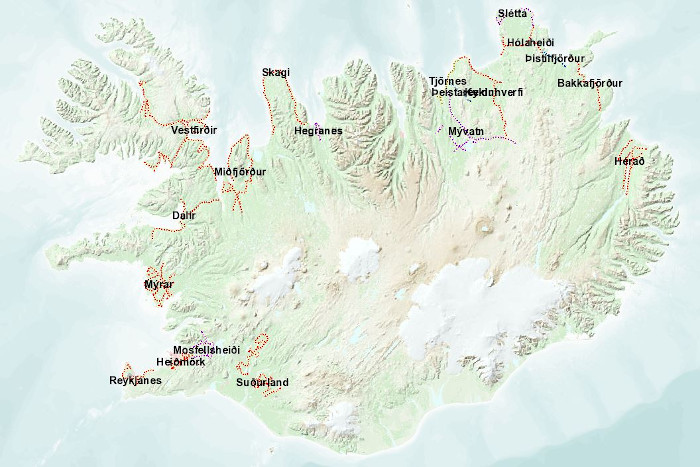Monitoring of rock ptarmigan population

The rock ptarmigan is the main game bird in Iceland. The population is monitored on an annual basis to ensure a sustainable harvest. This is done through counts, estimations of population age ratios, measurement of body condition, and registration of hunters’ catch and effort. The Icelandic Institute of Natural History is responsible for ptarmigan counts, estimation of age ratios and assessment of body condition. The Environment Agency of Iceland (EAI) collects hunting statistics.
Counts
Territorial ptarmigan cocks are counted in spring in some 40 areas within Iceland. Research has demonstrated that almost all ptarmigan cocks establish territories in spring and that the sex ratio within the breeding population is equal. Based on these assumptions, the density time series are used as population indices. Two methods are used in the counts: plot counts and distance sampling.
Ptarmigan counts – Click the double-pointed arrow in the lower right corner to expand the graph
Ptarmigan counts original data (excel) – Icelandic Institute of Natural History

Age ratio
Two age classes can be determined for ptarmigan: first-year birds (juveniles) and adults. Age ratios are sampled three times per year: in late summer (late July–early August), during the hunting season (November), and in spring (April–May).
Ptarmigan age ratio – Click the double-pointed arrow in the lower right corner to expand the graph
Ptarmigan age ratio original data (excel) – Icelandic Institute of Natural History
Hunting
The EAI issues hunting cards on an annual basis. Hunting cards are mandatory and are not re-issued unless the hunter returns a report for the previous year stating the annual catch, hunting region, and effort (hunting days). Hunters who do not reside in Iceland must have two domestic sponsors in order to participate.
Ptarmigan hunting – Click the double-pointed arrow in the lower right corner to expand the graph
Ptarmigan hunting original data (excel) – The Environment Agency of Iceland
Body condition
The body condition is determined in autumn using juvenile and adult carcasses from hunters. When this data is collected in November, juvenile birds are around 4 months old. The body condition index (BCI) is a measure of vitality, as there is a relationship between BCI and subsequent winter survival rate.
Ptarmigan body condition – Click the double-pointed arrow in the lower right corner to expand the graph
Population size, total harvest and harvest ratio
Careful monitoring is a prerequisite for sustainable harvest. The time series can be used to study long-term trends of the different variables. The data series can also be used to calculate population size, mortality rate and harvest rate. Due to a major decline in the ptarmigan population, a hunting moratorium was issued for 2003 and 2004. Hunting regulations were subsequently changed in 2005, at which time all commercial hunting and sale of ptarmigan was prohibited. This has resulted in a dramatic change in both hunting effort and harvest rate.
Ptarmigan population size, total harvest and harvest ratio – Click the double-pointed arrow in the lower right corner to expand the graph
IINH Contact: Ólafur K. Nielsen